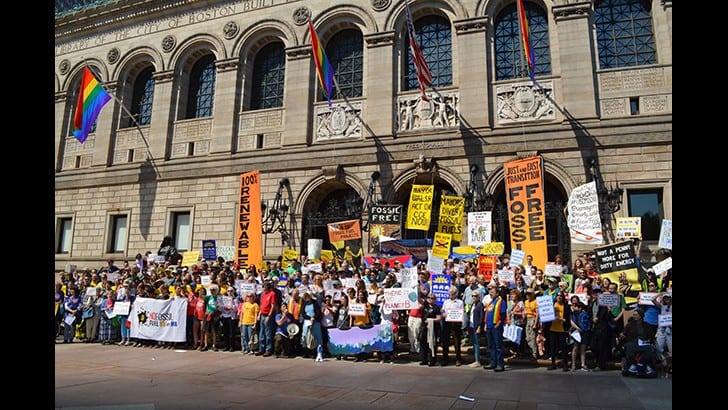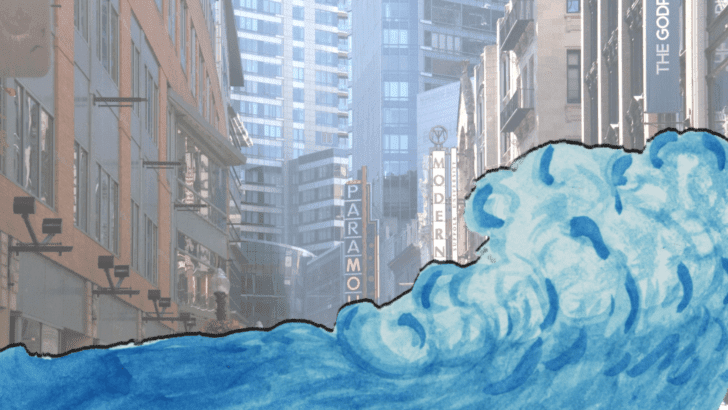
Mayor Walsh needs to act faster to mitigate regional global warming threats
June 13, 2018
BY JASON PRAMAS @JASONPRAMAS
Environmental groups protested Mayor Marty Walsh last week during the International Mayors Climate Summit and subsequent US Conference of Mayors meeting—demanding fast action to make Boston carbon neutral (achieving net zero CO2 emissions) and better prepare the city for the many threats to the region from the already-visible effects of global warming. Like the two “once in a generation” storms this winter that both quickly flooded our waterfront.
According to WGBH’s Greater Boston, “The good news, for advocates who think the city is falling short, is that Walsh says he welcomes public pressure in this area—and that big changes to the way the city operates are coming. Soon.”
The bad news, of course, is that pols can say anything they want. But are unlikely to act until their feet have been held to the fire. So, kudos to area climate activists for continuing to do that.
Interestingly, the summit was scaled down from a huge confab that would’ve hosted thousands of public leaders from the US and China in 2017 to a smaller 2018 conference that featured “20 US mayors and four officials from cities in other countries, including China,” according to the Boston Globe.
Walsh is doubtless happy to blame the election of the Trump administration for the lack of State Department support for the conference leading to a year’s delay and the lower turnout. Democrats like himself and former Secretary of State John Kerry—who originally announced Boston summit plans in Beijing in 2016—are getting a lot of political mileage out of poking holes in Trump’s slavish support of the oil, coal, and natural gas industries that are directly responsible for global warming. While pointing to his pulling the US out of the Paris climate accord by 2020 as tantamount to ecocide.
Unfortunately, the Democrats have been no less slavish in their support of the oil, coal, and natural gas industries at every level of government. And the Paris agreement is perhaps the best example of that slavishness.
Because the Paris climate accord is voluntary. So, even in countries that ratify it, the treaty can’t force the fossil fuel industries and the governments they often effectively control to do anything. No surprise there, since the process that launched it—the annual Conference of the Parties of the United Nations Framework Convention on Climate Change—allows fossil fuel corporations to participate in everything from funding its meeting sites to directly influencing its negotiations and implementation rules, according to 2015 and 2017 reports by Corporate Accountability International (CAI, formerly INFACT). An advocacy group that previously helped organize the Network of Accountability of Tobacco Transnationals—a coalition of mostly third world NGOs that helped exclude nicotine purveyors from the Framework Convention on Tobacco Control, a World Health Organization treaty process. CAI and its allies have repeatedly called for the fossil fuel industries to be similarly banned from participation in the negotiation of climate change treaties. To no avail, thus far.
One can certainly argue, and many do, that having even a voluntary treaty on global warming is better than not having one at all. But if multinational energy corporations like ExxonMobil, Shell, BP, Chevron, Peabody, and BHP Billiton were willing to voluntarily phase their fossil fuel lines out of existence, I would think that they would be well on the way to carbon neutral status by now. After all, most of them knew about the dangers of global warming decades back. According to a timeline by Climate Liability News, Exxon knew in 1977, Shell in 1988, and those companies and many others formed the Global Climate Coalition specifically to cast doubt on climate science in 1989.
Almost 30 years later, it seems foolish to bet on companies that make obscene profits by selling fossil fuels to suddenly have a change of heart and agree to stop making those superprofits.
Circling back to Boston, Mayor Walsh drew fire from groups like 350Mass and Mass Sierra Club last week on largely the same grounds. The city is not doing much more than drafting plans to implement mainly voluntary measures to mitigate the effects of global warming in the coming years.
It’s also working on those plans—formally and informally—with major corporations that play a variety of roles in worsening global warming. From investing in fossil fuel industries to developing environmentally unfriendly buildings. And it’s potentially underestimating the threat from global warming by choosing to ignore more dire climate models in its planning that are still well within the mainstream of climate science. City government is also not addressing all the major systemic “tipping points” under investigation by climate scientists that could conceivably affect the Boston area and their interrelation to each other. Focusing instead on three imminent threats: sea level rise, air temperature rise, and more intense storms.
Major planning processes on minimizing the risks presented to us by global warming are absolutely necessary and a difficult undertaking at the best of times. Yet there’s little sense that Boston’s developing climate plans are going to result in the policy pedal being pushed to metal anytime soon. Hence, last week’s protestors’ event hashtag: #WalktheTalkonClimate. The environmental groups made clear that we need Mayor Walsh and the rest of city government to take swift action to reduce the many threats from runaway global warming as much as any one city or region can… and do less talking about the need to take swift action.
That means divesting the city of all financial holdings in fossil fuel corporations. And moving on the Boston City Council’s resolution of last fall unanimously supporting “Community Choice Energy”—a plan that would allow Boston to join with other municipalities in buying energy in bulk on behalf of residents and small businesses. Enabling the city to mandate a higher percentage of renewable energy in such purchases. Then creating regulations with real teeth aimed at mitigating the many likely harms to our city from climate change.
For example, Boston (and the Commonwealth) can enact regulations that would force developers of the millions of square feet of new building projects sprouting up around the city to prepare for flooding from global warming-induced sea level rise. Especially new construction in the city’s now massively overdeveloped waterfront. Hub solons can also pass regulations that would compel those same developers to power new buildings with genuinely renewable energy (i.e., not natural gas or nuclear). And regulations that would also make such buildings as energy efficient as possible.
Beyond that, the city should get going on actually building flood defenses and neighborhood cooling centers; and pressing ahead with operationalizing other big ideas currently under discussion in various city planning processes. Or outside of them in my case—as with my support for moving key city infrastructure to higher ground at speed, and eventually moving the seat of Massachusetts state government to Worcester.
Ultimately, properly preparing the city to deal with the negative effects of global warming is everyone’s job. Because politicians can’t do it all themselves. Nor should they. So, readers should contact the mayor’s office regularly to demand faster action on the issues mentioned above, participate in relevant public hearings and meetings to make your voices heard, and get active with any of the environmental organizations large or small that look to be fighting hardest in the public interest.
Just remember, Bostonians failing to be vigilant can result in city government dropping the ball on even fairly straightforward climate-related promises. Like former Mayor Thomas Menino’s plan to plant 100,000 new trees by 2020. As of this month, there’s been a net gain of 4,000 trees since the initiative was announced a decade ago.
In the same period, New York City promised to plant 1,000,000 new trees by 2017. And reached that goal two years early. They’re also well ahead of Boston with global warming preparations.
Worth considering why that might be. Before the next mayoral election.



